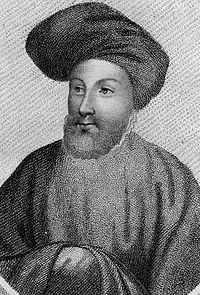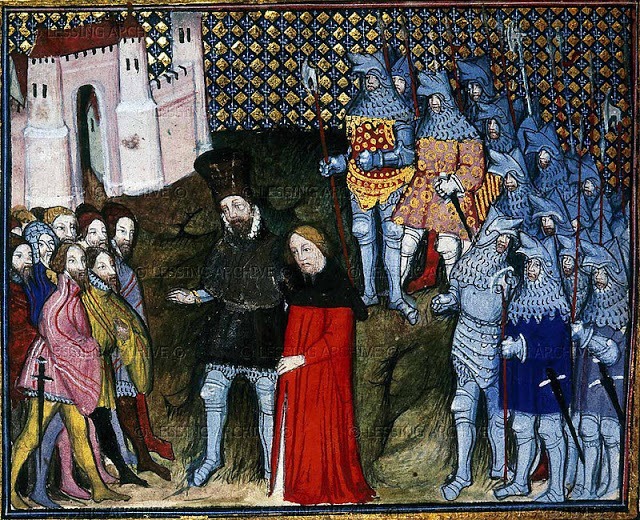Edward of Norwich, the 2nd Duke of York was an English nobleman and a person of royal patronage. He was the son of Edmund of Langley, the 1st Duke of York and was the grandson of Edward III of England and Philippa of Hainault.
Born into riches, his maternal grandparents were King Pedro of Castile and Maria de Padilla. He died at the age of 42 in the Battle of Agincourt. Edward also wrote “The Master of Game”, one of the oldest books on hunting.

Early Life
Contents
Edward was born in the year 1373 probably in Norwich. He was the oldest son of the Duke of York and his mother was Isabella of Castile, daughter of Pedro the Cruel of Castile.
Edward had a younger sister Constance who was born just a year apart and a brother Richard, the 3rd Earl of Cambridge.
Political Career
Edward was very close to his cousin King Richard II of England. On 16 July 1377, during the coronation of Richard II, Edward received his Knighthood. He was only 4 at that time.
Edward was very loyal and shared an intimate relationship with Richard II. He received several important grants and titles during his lifetime including the Order of Garter on May 1387.
On 1390, Richard II appointed his favorite cousin the Earl of Rutland and the Earl of Cork in 1394. Edward held several important offices and duties during Richard II’s tenure as the King of England.
After the death of Richard’s wife Anne of Bohemia, Edward was entrusted with the control of several of the estates of Queen Anne.
Edward, Duke of Aumale
Thomas of Woodstock, Duke of Gloucester and Lords Appellants always posed a threat to the reign of Richard II. They made several attempts to oppose his rule. In 1397, Gloucester was imprisoned and murdered at Calais probably on Richard’s orders. Edward was said to have played a major role in the assassination.
After Gloucester’s death, Edward forfeited several of his lands and was made the Duke of Aumale and the Constable of England. However, he was removed from his position after the usurpation of Henry IV.
Marriage and Children
Edward a young man of 25 was the most eligible bachelor in town and was likely to inherit the Dukedom from his father in near future. Richard II took the initiative to arrange a match for his cousin brother.
Though Richard II made several attempts to get Edward married to his relatives, the future had other plans.
The much eligible bachelor found his match and got married in 1398. The marriage was an unconventional one. Edward who was quite young got married to Philippa, daughter of John Mohun, the 2nd Baron Mohun and a member of the Order of the Garter.
Phillipa was 20 years older than Edward and was widowed twice. She had no inheritance or prospective dowry, so their marriage suggests that it must have been a love match. The couple was childless and Edward eventually adopted his nephew as his legal heir.

Epiphany Rising
Epiphany Rising was a failed attempt of revolt against Henry IV of England that took place between December 1399 and January 1400.
The usurpation of Henry IV was a matter of concern for Richard as now he was also a prime suspect of Gloucester’s murder, decided to plot the capture of Henry IV on the feast of Epiphany.
The main agitators were John Mantagu, 3rd Earl of Salisbury, John Holland, 1st Earl of Huntingdon, Thomas Holland, 3rd Earl of Kent, Ralph Lumley, 1st Baron Lumley and Edward of Rutland.
The agitators met on December 1399 at the Abbey House in Westminster and decided to capture and kill Henry IV at the feast of the epiphany. However, Edward feared to rebel against Henry IV, the promising King of England and betrayed his alliance with Richard.
The aftermath of the revolt proved to be quite hazardous for Edward. He was imprisoned on 20 October 1399 and was stripped of his power as the Constable of England and Duke of Aumale.

Edward during the reign of Henry IV
Edward’s role in the conspiracy of Henry IV was not properly proven and it seemed that the newly appointed king has not lost his faith in Edward.
Edward was acquitted from his charges and pardoned a death sentence by an act of Parliament in 1401. Following that, he was made the Royal Lieutenant of Wales and became the Duke of York on his father’s death in 1402.
In 1405, Edward’s younger sister Constance the widow of Thomas le Despencer, Earl of Gloucester alleged him of instigating the plot of murder against her husband and the king himself. Edward was imprisoned and later released by the Privy Council whereby he regained all his estates and continued serving Henry IV in Wales and France.
Battle of Agincourt: The Hundred Years’ War
The Battle of Agincourt led by King Henry V of England was a power struggle between England and France.
On 25 October 1415, Edward who commanded the right wing died saving King Henry V at the battlefield.
Edward was buried at the Church of St Mary and All Saints in Fotheringhay, Northamptonshire. Later Queen Elizabeth erected a monument in his honor.
